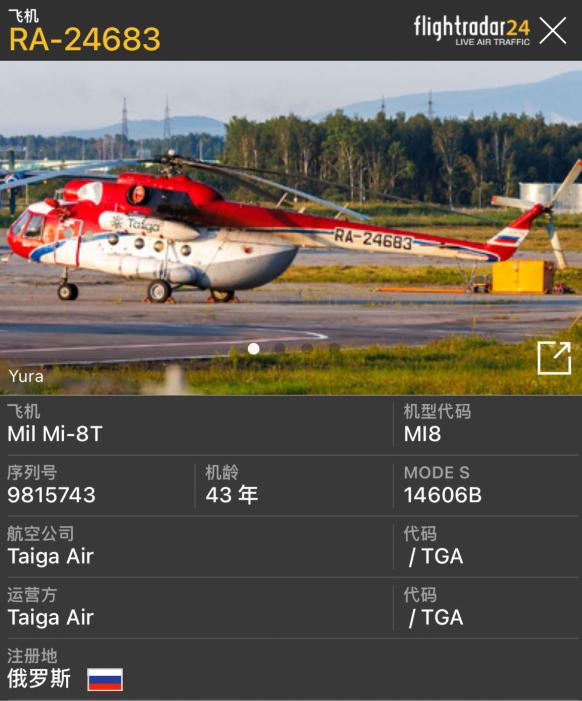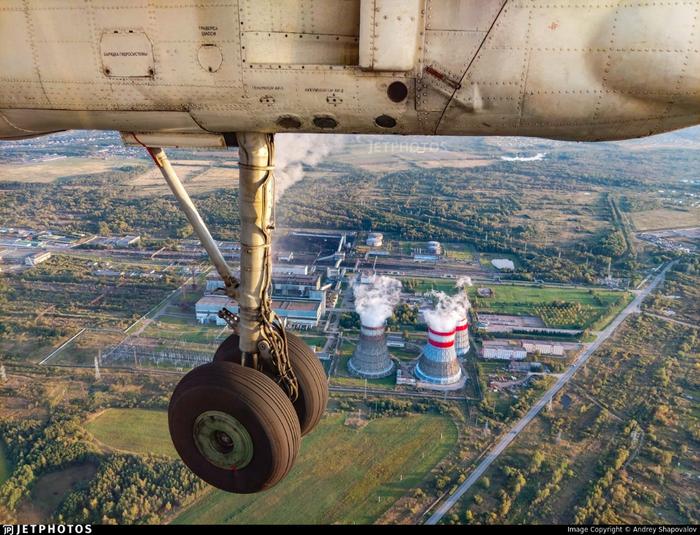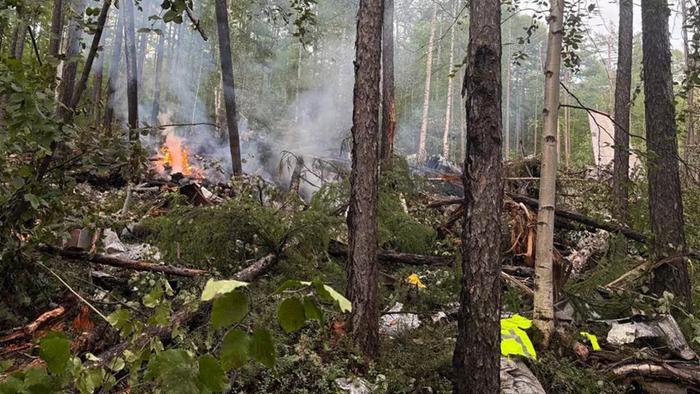



On July 24th, a passenger plane operated by Androla Airlines, en route from Bahrain to Bratsk to Tengda, experienced an accidental loss of contact while landing at Tengda Airport. Subsequent confirmation revealed that the aircraft had crashed into the forest 15 kilometers away from the airport, resulting in the death of all 49 passengers on board, including a Chinese citizen.
The site of the crash of the Antonov AN-24 aircraft near Tengda Town in Amur Region, Russia
Photo from the Russian Far East Transport Prosecutor’s Office
The aircraft involved was the An-24, a predecessor model of our country’s Yun-7. This An-24, produced during the Soviet era in the 1970s, is over fifty years old and can be considered a vintage aircraft. According to reports from Russia, the plane initially attempted to land at Tengda Airport due to poor weather conditions and chose to make an emergency return. However, it lost contact with the ground and disappeared from radar during its second attempt to land.
Due to the An-24 being too old and not equipped with an ADS-B device, and considering the vast uninhabited areas in the Far Eastern region of Russia, the flight information of the crashed aircraft was not collected by websites such as FlightRadar24. Consequently, there was no analysis of the final state of the aircraft’s crash. Additionally, since Tengda Airport is too small, its METAR weather messages were not recorded by relevant weather message websites, making it impossible to analyze the meteorological conditions at the time of the incident based on these messages. It was only possible to learn from reports from Russia that the weather was poor at the time of the first emergency landing.
Although a detailed analysis of this air disaster cannot be conducted at this time, some clues can still be found through subtle indications.
The crash site was 15 kilometers away from the airport, and the first landing attempt failed due to weather conditions. Consequently, the aircraft was circling around the airport in a state of waiting for better weather conditions, often at altitudes of over a kilometer. The low visibility made it unlikely that the aircraft would hit a mountain, as seen from the accident scene. The terrain was relatively flat, which also did not fit the scenario of hitting a mountain.
Considering the age of the aircraft, which has exceeded fifty years, its equipment is already outdated, and the aircraft is severely aged. There is a higher likelihood of mechanical failure or ice formation leading to loss of control or stalling. However, it’s also possible that pilots might experience space vertigo due to adverse weather conditions, resulting in the crash. After all, any accident involving an aircraft with a service life longer than the pilot is possible.
According to reports, this aircraft had experienced at least two technical faults since 2022: one was a mid-engine failure in May 2022, and another was a radio communication failure before takeoff in Irkutsk in March 2023, forcing a return flight. It can be inferred that maintenance issues caused by long-term service may have increased the risk of accidents. Moreover, the accidental airline, Angar Airlines, serving as a regional carrier in the Far East, has a poor safety record, making it plausible that improper maintenance of older aircraft could lead to mechanical failures.
The crashed An-24, serial number RA-47315. Seems okay, right? This photo was taken in 1999.
The specific cause of the accident awaits investigation by Russia. However, this air disaster occurring in the Far East region is not surprising to me—it reflects the systematic challenges faced by the aviation industry in the Far East region of Russia.
This area is vast and sparsely populated, with many towns and remote villages lacking reliable land transportation and relying solely on air connectivity.
Taking the Tandach Airport in Amur Region, which is the location of this accident, as an example, it covers an area of 360,000 square kilometers, similar to Yunnan in China. However, its population is only 750,000 people, distributed sparsely. Moreover, due to the weak infrastructure development in the Far East region, with limited roads and railways, air transport, which relies less on infrastructure, has become the transportation pillar for the Far East region, even being the sole means of transportation for some remote settlements to the outside world. In other words, under these geographical conditions, developing regional air transport is not a choice but a fundamental need. The Soviet era’s most successful regional jet, the Yak-42, was designed for the vast Siberian region’s aviation needs, focusing on the idea that as long as there’s a flat surface, even without a runway, it can fly.
However, during the Soviet period, Russia had the strength to support the Far East’s aviation network. After the dissolution of the Soviet Union, facing the aviation needs of the Far East, Russia had to rely on the market’s solution. Taking the Far Eastern regional airlines represented by Angar and Yakut airlines as examples, these airlines are small in scale and have weak profitability, relying solely on a small amount of government subsidies and their modest income to keep going. Most of their fleet consists of aircraft manufactured during the Soviet era—An-24 and An-26, as well as various old Soviet helicopters, including An-2, which shows the safety standards are quite high.
According to normal service life, many of these planes are nearing the design service life limit, which should be gradually retired within the next few years. However, reality is “the market we are in today does not have replacement models for An-24 and An-26.” Without new aircraft available for replacement, airlines can only request to extend the service life of the An-24 series, allowing these “grandfather” aircraft to continue flying. The An-24 involved in this crash was extended its service life until after 2030.
Half a month ago, a friend who frequently travels to the Far East of Russia introduced me to a trip plan that seemed quite interesting at the time. After crossing the Heilongjiang port, there are auxiliary flights operated by helicopters with the Mi-8 in the Russian side, which can carry a large number of checked baggage. Naturally, I was very interested in learning more about it, but as I listened, my mood became increasingly uneasy, and I eventually fled in a hurry. What happened?
This Mi-8 helicopter flight from Bakhorovsk (coincidentally, this accidental flight also started from here) to Amur Jet is only priced at 1000 rubles (about 90 RMB), and some dates even cost only 500 rubles (45 RMB). The flight duration is two hours. As someone with ample aviation knowledge, hearing this, I instinctively felt scared and dared not take the flight. However, what followed gave me a shock: the Mi-8 helicopter used for the flight is an 1981 model, older than me by a whole generation. So I joked with my friend, if I were to fly on this Mi-8 helicopter flight, would I need to write out a crash analysis beforehand, so that when something goes wrong, the editor could fill in “This article was published when the author unfortunately died.” As for the joke, it came true half a month later in another form, which was another sad story.
Flying for just 500 rubles can reach your destination in two hours with a Mi-8. This is the auxiliary air transport in the Far East of Russia.
As for the Mi-8 helicopter used for the flight, it shares the same year as the Antonov An-24.
Of course, the difficulties faced by the Far Eastern airlines in Russia are not just old aircraft, low ticket prices, and harsh weather and geographical conditions; they also include increasingly difficult maintenance work.
Take the An-24 for example, which was already discontinued during the Soviet era and its production base was located in the Kyiv factory of Antonov. After the dissolution of the Soviet Union, parts needed to be imported from Ukraine or other countries.
At the current third year of the Russia-Ukraine war, conventional channels have naturally become irrelevant.
Although parts can be obtained through gray channels such as smuggling, this is merely a drop in the bucket and cannot truly solve the problem. Moreover, Russia tends to prioritize securing the materials for major airlines like Aeroflot, leaving the smaller regional airlines with their own unique solutions in the Far East.
Currently, Russia is attempting to alleviate this crisis through multiple approaches.
On one hand, efforts are being made to develop domestically produced alternative aircraft models, such as the new generation turboprop regional passenger aircraft TVRS-44 “Ladoga” that is on par with An-24. However, the mass production of “Ladoga” could not commence until after 2027, delaying the plan by many years. Meanwhile, larger Siberian Aircraft Corporation’s Superjet 100 and Irkutsk Airways’ MC-21 wide-body passenger aircraft are also being developed for domestic modification, but they will not significantly help in remote regional routes in the short term, and some routes may not be feasible for takeoff and landing.
On the other hand, the Russian government is integrating the airlines in the Far East, consolidating five existing companies into Polaris Airlines. However, without new aircraft, even consolidation remains with the old planes, essentially nothing more than water without a source or root without a tree. By 2025, the Far East of Russia will still rely heavily on its Soviet era veterans.
The Far East region is far from Russia’s core area and has always been considered an underdeveloped region since the dissolution of the Soviet Union. After the outbreak of the Russia-Ukraine conflict, although local young men signed up as contract soldiers to actively participate in the “special military operation,” obtaining certain “transfer payments” through high wages or generous compensation packages, they still remain in a state of lacking investment and development, with the aviation industry being just one aspect of the problems.
Russian President Vladimir Putin signed the “Far Eastern 1 Hectare Land Law” on May 2, 2016, to attract Russians to settle in the Far East region to promote development there.
The Far East region is far from Russia’s core area but is close to the Northeast China region. In my view, Russia could consider opening up its aviation market moderately in the Far East region, encouraging external investment and operators from China, among others, to jointly enhance regional aviation transportation capabilities. The common challenges faced by Far East Airlines are a lack of funds and lack of scale effects. However, with China’s substantial capital and strong interest in the development of the Far East, it has full potential to play a role in this field.
During an interview during the 7th Eastern Economic Forum, Russian Deputy Prime Minister and Presidential Representative for the Far East Federal District, Trutnev, stated that over 90% of foreign investments in the Far East region come from China. This means that China has become the largest source of foreign investment in the Far East region, investing heavily in infrastructure, resources, and energy sectors.
In the aviation sector, China can also be involved in building airports, joint ventures with airlines, and developing air logistics projects. If Chinese aviation companies or financial leasing companies participate in the restructuring of Far East branch airlines, they can not only bring in urgent funds but also introduce China’s advanced experience in aviation management and market operations into Russia, effectively improving the operational situation of Far East regional aviation and achieving a win-win situation for both China and Russia.
Of course, solving the difficulties faced by Far East Airlines cannot be achieved overnight; it requires cooperation between Russia and neighboring countries, especially with China to build an integrated regional aviation network. This will further open and increase direct flights between China and Russia, as well as between the Far East and other countries in Northeast Asia.
Currently, Polar Airways has launched regular flights from Sevastopol, Khabarovsk, and other places to Beijing, Dalian, Harbin.
In the future, it might be considered to add more direct flights from Russian Far Eastern cities to major Chinese Northeast cities, facilitating business and tourism exchanges. For instance, flights directly from Yakutsk or Bratsk to Harbin or Shenyang; and flights from Peterograd in Kamchatka to Dalian or Qingdao, enhancing economic integration between the Far Eastern region of Russia and the Northeast region.
Everyone understands the principle, but the question is whether Moscow can make this decision?
This article is an OAN submission, and the content is solely the author’s personal opinion, not representing the platform’s viewpoint. Otherwise, legal responsibility will be pursued. Follow OAN on WeChat for daily interesting articles.